Easter C. Osuchukwu1, Chinwe S. F. Ezeruigbo2, Jimmy E. Eko3
1Department of Nursing Science, Faculty of Allied Medical Science, University of Calabar, Calabar, Nigeria
2Department of Nursing Science, Ebonyi State University, Abakalika, Nigeria
3Department of Sociology, Faculty of Social Sciences, University of Calabar, Calabar, Nigeria
Correspondence to: Jimmy E. Eko, Department of Sociology, Faculty of Social Sciences, University of Calabar, Calabar, Nigeria.
| Email: |  |
Copyright © 2017 Scientific & Academic Publishing. All Rights Reserved.
This work is licensed under the Creative Commons Attribution International License (CC BY).
http://creativecommons.org/licenses/by/4.0/

Abstract
Poor umbilical cord care practice is largely responsible for 33% of neonatal mortality in Nigeria. This study was aimed at assessing the knowledge of standard umbilical cord management among mothers in Calabar South Local Government Area of Cross River State. The research design was a descriptive cross-sectional study and the snowball sampling technique was used to select four hundred and fifty-one (451) respondents from 22 clans that made up Calabar South Local government Area. A 38-itemed semi-structured questionnaire constructed by the researcher was used for data collection from eligible respondents. Data generated were coded and analysed with SPSS software and results were expressed in percentages, means, standard deviation and presented in Tables. Chi-square was used to test for association between variables at alpha level of .05. Findings of the study showed that most respondents 372 (82.7%) lack knowledge on cord separation time, 337 (74.9%) benefit of umbilical cord care and 249 (55.3%) meaning of standard core care. Age (χ2 = 16.07; P = 0.000), educational status (χ2 = 25.51; P = 0.000) and marital status (χ2 = 17.82; P = 0.000) were statistically significantly associated with knowledge of standard umbilical cord management among mothers. Hence, redesigning the focused health education to include relevant stakeholders involved in neonatal and child care is crucial to improve mothers’ knowledge level on standard umbilical cord management.
Keywords:
Knowledge, Umbilical cord management, Neonatal, Mothers
Cite this paper: Easter C. Osuchukwu, Chinwe S. F. Ezeruigbo, Jimmy E. Eko, Knowledge of Standard Umbilical Cord Management among Mothers in Calabar South Local Government Area, Cross River State, Nigeria, International Journal of Nursing Science, Vol. 7 No. 3, 2017, pp. 57-62. doi: 10.5923/j.nursing.20170703.01.
1. Introduction
Globally, about 130 million babies are delivered annually, 4 million (3.1%) die within the first 4 weeks of life and 25 percent of these deaths are as a result of umbilical infection [1]. In developing countries, most of the cord care is home based since two third of births take place at home [2]. Evidence-based report have shown that, globally, about 150,000 neonates die annually from omphalitis [1]. Each year some 600,000 infants die of neonatal tetanus in Africa; in untreated cases, case fatality rate approach 100% and a further 460,000 die as a consequence of other severe bacterial infections [1]. In Nigeria, several hospital-based studies have reported cases of umbilical cord infections. For instance, in Port Harcourt, umbilical cord infection accounted for 10% of neonatal admissions and 30% of neonatal deaths [3]. A review of umbilical infection in Ibadan showed that it accounts for 18% of neonatal deaths [4]. In Calabar South Local Government of Cross River State, 49% of neonatal deaths were due to umbilical cord infection while the condition was responsible for 19% of all newborn admissions [3]. Many of the neonatal deaths occur at home and therefore unseen and unaccounted for in official statistics [5-7]. According to the reports, many of these neonates are brought in for admission in very bad state, consequently resulting in neonatal deaths. Unfortunately, these statistics reflect the hospital facility situation and little or no information is available for cases of home neonatal deaths from umbilical cord infection. From the foregoing, considering the poor health indices, it is therefore pertinent to assess the knowledge level of mothers on standard umbilical cord care management. This assessment is imperative because, it is believed that good knowledge can translate to good practices as well as better health outcome. Hence, this study seeks to determine the knowledge level of umbilical cord care and management among mothers in Calabar South Local Government Area of Cross River State, Nigeria.
2. Methodology
The study design for this study was a descriptive cross-sectional survey design. This design was considered suitable for the study because it largely involves drawing a sample or subset from a universal population. It also involves the collection, collation, analysis and interpretation of data generated from the respondents [8]. The study area was Calabar South Local Government Area, Cross River State, Nigeria. It has 10 political wards with an estimated population of 191,630. The area is mostly inhabited by the Efut, Efiks, Quas and Ibibios who are largely civil servants, businessmen/women, traders, farmers and fishermen [9, 10]. The sample size for this study was calculated to be 451 using Isangedihi et al [8] formula to obtain a single finite proportion. Since Calabar South has 22 clans, the number of respondents were equally distributed to each clan where 5% of the respondents were selected from each clan based on their eligibility to participate in the study. The snowball sampling technique was used to select the respondents such that when the first respondent is identified, the researcher was subsequently referred to other eligible respondents. Respondents were mostly gotten in health centers, churches and their homes. A semi-structured questionnaire was designed in line with the stated objectives by the researcher and used to generate data from the respondents.The face and content validity method was used to measure the validity of the instrument where the project supervisor in conjunction with two experts from related disciplines were involved in scrutinizing the questionnaire for relevance of content, clarity of statements and logical accuracy of the questions asked. Thereafter necessary adjustments were made. A test retest reliability method was used to ascertain the reliability of the instrument. The results obtained was analysed using Pearson Product Moment Correlation Coefficient (PPMCC) to obtain a reliability index of 0.99 which was considered appropriate for the study. Ethical approval for the study was obtained from Cross River State Ministry of Health Research Ethics Committee. Informed consent was also gotten from the respondents verbally before recruiting them to partake in the study. Anonymity and confidentiality of information they provided was maintained throughout the period of research. Data obtained were analysed using Statistical Package for Social Science (SPSS version 18.0) software and results were presented in Tables and simple percentages. Chi-square was used to test for the association between variables at 0.05 alpha level. To determine the knowledge score, items provided for each variable had one correct option and the others were wrong options. Respondents who were able to identify the correct option was categorized as having good knowledge of Umbilical Cord Management while those who selected the wrong options was considered having poor knowledge of Umbilical Cord Management. Thereafter, the average knowledge score was obtained.
3. Results
Socio-demographic characteristics of respondentsOut of 451 questionnaires distributed, 450 was correctly filled and returned for analysis giving a response rate of 99.7%. The results in Table 1 shows that most respondents 238 (52.9%) were between the age bracket of 26-36 years with mean age of 26 and standard deviation of 12. A greater proportion of the respondents were 390 (86.7%) married, 444 (98.7%) Christians, 188 (41.8%) had secondary education, 156 (34.7%) engaged in petty trading and 316 (70.2%) earned N18,000 and less per month. Table 1. Socio-demographic Characteristics of Respondents (n = 450)
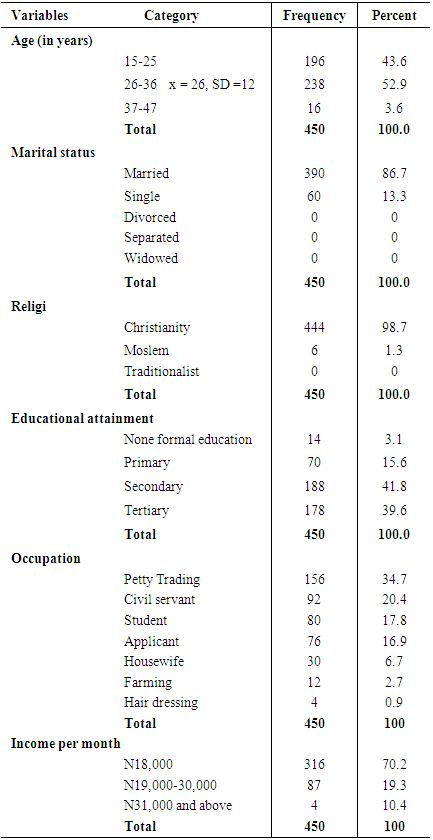 |
| |
|
Knowledge of Standard Cord Care among RespondentsResults in Table 2 shows that 201 (44.7%) respondents felt standard cord care means tying the cord stump, cutting it with a clean object and cleaning with methylated spirit only with no application of any other material which accounted for good knowledge, while others who defined standard cord care as 141 (31.3%) the use of herbs and isolation of baby, 76 (16.0%) the use of herbs and 32 (7.1%) nothing on the cord till separation accounted for poor knowledge.Table 2. Knowledge of Standard Cord Care among Respondents (n = 450)
 |
| |
|
Source of knowledge of Umbilical Cord Management among RespondentsAs presented in Table 3, sources of information or knowledge on umbilical cord management included; 187 (34%) mother/mother-in-law, 164 (29.4%) church members, 149 (27.1%) health workers and 52 (9.5%) Traditional Birth Attendants. Table 3. Source of knowledge of Umbilical Cord Management
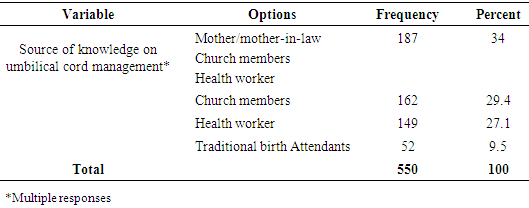 |
| |
|
Knowledge of material used for tying the umbilical cord among respondentsResults in Table 4 shows that 225 (56.7%) respondents identified cord clamp as the material used for tying the cord which accounted for good knowledge while others who identified 176 (39.1%) hair thread, 17 (3.8%) rubber band and 2 (.4%) string of cloth accounted for poor knowledge.Table 4. Knowledge of Material Used for Tying the Cord (n =450)
 |
| |
|
Knowledge of solution used in cleaning umbilical cord among respondentsResults presented in Table 5 shows that shows that 254 (56.4%) respondents use methylated spirit as cleansing solution of umbilical cord which accounted for good knowledge, while others who used 88 (19.6%) herbal solution, 66 (14.7%) salt mixed with saliva and 42 (9.3%) hot water accounted for poor knowledge.Table 5. Knowledge of solution for cord cleaning (n=450)
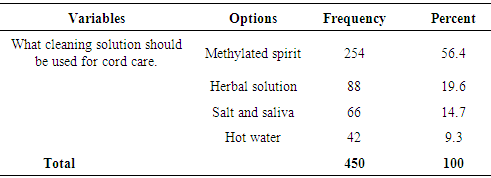 |
| |
|
Knowledge of cord separation time among respondentsResults presented in Table 6 shows that 372 (82.7%) respondents felt that it takes 3-4 days for the cord to separate or detach which accounted for good knowledge while 78 (17.3%) respondents who felt it takes 5-15 days accounted for poor knowledge. Table 6. Knowledge of cord separation time (n =450)
 |
| |
|
Knowledge of benefits of umbilical cord care Results presented in Table 7 shows that 220 (48.9%) respondents felts that the advantage of umbilical cord care was to wade off evil spirits, 87 (19.3%) prevent neonatal tetanus and 30 (6.7%) prevent abdominal pain which accounted for poor knowledge, while 113 (25.1%) respondents who felt is to prevent infection accounted for good knowledge.Table 7. Knowledge of benefits of umbilical cord care (n = 450)
 |
| |
|
Knowledge score of standard umbilical cord care among respondentsAs shown in Table 8, on the average, 180 (40.0%) respondents have good knowledge of standard umbilical cord care while 270 (60.0%) have poor knowledge.Table 8. Knowledge score of standard umbilical cord care among respondents
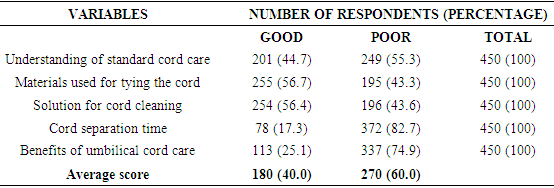 |
| |
|
Test of association between socio-demographic characteristics of respondents and knowledge of standard umbilical cord careIn Table 9, it was observed that age (χ2 = 16.07; P = 0.000), educational status (χ2 = 25.51; P = 0.000) and marital status (χ2 = 17.82; P = 0.000) were statistically significantly associated with knowledge of standard umbilical cord management among mothers. Hence, the null hypotheses were rejected and the alternative accepted. Table 9. Test of association between socio-demographic characteristics of respondents and knowledge of standard Umbilical Cord Care
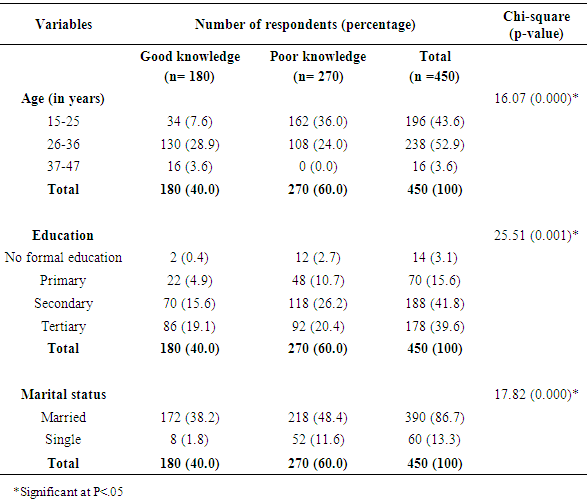 |
| |
|
4. Discussion of Findings
From the results obtained, it is clearly indicated that most respondents 270 (60.0) had poor knowledge of standard umbilical cord management. This finding corroborates with that of [11] and [6] where poor knowledge of umbilical cord care was equally reported, but disagrees with findings of Luka [12] where majority of the mothers knew standard hygienic cord care. The poor knowledge documented in the current study could be attributed to their sources of information and poor access to correct and factual information on umbilical cord care. It was earlier reported in this study that majority of the respondents had their information on umbilical cord management from their mothers, mother-in-laws, church members and Traditional Birth Attendants. Only 149 (27.1%) respondents had their source of information from health workers. In this case, the health workers are believed to be the most reliable source of information on umbilical cord care because of their exposure to several trainings, skills and experiences. Health workers are also exposed to regular updates on current pediatrics practices which is applied to mitigate neonatal morbidity and mortality as well as improve their health outcome. On the other hand, mothers, mother-in-law and church members may rely on speculations, misconception/myths, traditional belief systems and previous experience to provide health information to their daughters and daughter-in-laws which may completely negate WHO recommended standard of umbilical cord care. It is pertinent to state that since mothers and grandmother play a significant role in improving maternal and child health due to their knowledge and previous experience, focused health education, information and communication should be target at them. This would provide the platform for acquisition of new knowledge, skills and enhance better practice of umbilical cord care.It was also observed that good knowledge of umbilical cord care was strongly associated with increasing age (P<0.05). Older mothers were more knowledgeable about umbilical cord management than their younger counterparts (Table 9). Previous experiences encountered overtime may largely account for the disparity. Also younger mothers mostly rely on their older counterparts for knowledge and guidance on appropriate child care. Women with higher educational status were found to be more knowledgeable than women with lower educational status (Table 9). This means that educational status plays a significant role in the knowledge of umbilical cord care. This may be linked to access to correct and factual information on care of newborns which is usually provided at formal health institutions. Regular hospital consultation, regular ANC visits and consultation of health care providers for most of their health needs may substantially contribute to their knowledge level among the educated mothers.Marital status was found to be strongly associated with knowledge of umbilical cord care where the married mothers had more knowledge than their single counterparts (P<.05) (Table 9). This may be influenced by the fact that once a married women gives birth as practiced in the most African culture, the mother or mother-in-law are present to provide technical support in proper child caring and rearing. Within this process, the married mothers learn by guidance and observation and become knowledgeable. For the singles, such benefits may not be available and as such lack the requisite knowledge for standard core management.
5. Conclusions and Recommendations
Standard umbilical cord care is pivotal to mitigating the rate of neonatal morbidity and mortality in Nigeria. This can only be achieved if mothers have adequate knowledge of standard cord care practices. Findings in this study showed that most respondents had poor knowledge of umbilical cord care. Hence, maternal health education should be re-patterned, restructured and re-designed to include standard cord management so as to provide correct information to women who attend antenatal care. Also, community-based focused health education on standard cord management should integrate grandmothers since they were reported to be a major source of information on umbilical cord management in the current study.
References
| [1] | Peter, O. & Johnson, J. (2010). Risk Factors for Neonatal Infections. Global Journal; 12:40-46. |
| [2] | World Health Organization (2009). Essential Newborn Care. Report of a Technical Working Group. Geneva P. 22-28. |
| [3] | Antai, T. E. & Effiong, F. O. (2009). Septicaemia among Neonates with Tetanus. Journal of Tropical Pediatrics 3 (10) 210-213. |
| [4] | Bennett. J. & Adetunde, T. (2010). Influence of Native Customs on Newborn Care in Nigeria. International Journal of Epidemiology; 25(4): 879-884. |
| [5] | Ambe, J., Bello, M., Yahaya, S. & Omotora, B. (2010). Umbilical Cord Practices in Konduga Local Government Area of Bornu State, North East Nigeria. Journal of Tropical Medicine 9 (6): 87 – 92. |
| [6] | Green, P. T., Udoh, E. & Peters, J. (2006). Clinical Study of Septicemia. Journal of Pediatrics 43: 328-332. |
| [7] | Garner, F. V. (2008). Care In Normal Birth: A Practical Guide. New York: Jack ken. P.18-31. |
| [8] | Isangedihi, A., Joshua, M., Asim, A. & Ekuri, E. (2004). Fundamentals of Research and Statistics, Calabar: University Press. |
| [9] | Eko, J. E., Abeshi, S. E., Osonwa, K. O., Uwanede, C. C., Offiong, D. A. (2013). Perception of Students’ Teachers’ and Parents’ towards Sexuality Education in Calabar South Local Government Area of Cross River State, Nigeria. Journal of Sociological Research; 4(2): 225-240. |
| [10] | Osuchukwu, N. C., Osuchukwu, E. C, Eko, J. E., Samson-Akpan, P. E., Akpasa, A. O., Osonwa, K. O., & Offiong, D. A. (2015). Perception of the determinants of maternal mortality in Calabar South Local Government Area of Cross River State, Nigeria. Journal of Public Heath, Pharmacy and Pharmacology 1(1): 1-13. |
| [11] | Senarath, T. R. (2010). Who Teaches Mothers How to Care for Babies Cords? West African Journal of Nursing 16 (1): 54. |
| [12] | Luka, J. W. (2009). Effect of Cord Regimen on Bacteria Colonization in Newborn Infants. American Academy of Pediatrics 79(9): 395-398. |



 Abstract
Abstract Reference
Reference Full-Text PDF
Full-Text PDF Full-text HTML
Full-text HTML







